Overview
Have you ever wondered what the future holds for software in the B2B space, especially for manufacturers in 2025? Well, let’s dive into some exciting trends that are shaping this landscape! We’re talking about advancements like:
- AI integration
- Cloud solutions
- Customer experience optimization
- Sustainability practices
These trends aren’t just buzzwords; they’re key to enhancing operational efficiency and improving client relationships.
Imagine how much smoother operations could be with AI helping to streamline processes! Additionally, cloud solutions offer flexibility and accessibility that can transform how manufacturers operate. And let’s not forget about customer experience optimization—after all, happy clients lead to stronger relationships and increased revenue growth.
But here’s the thing: to stay competitive in this ever-evolving digital world, manufacturers must embrace these innovations. So, what does this mean for you? It’s time to adapt and take action! By keeping up with these trends, you can ensure your business not only survives but thrives in the future. Are you ready to make the leap into this exciting new era?
Introduction
As the world of software B2B keeps changing, manufacturers are leading the charge in a digital transformation that’s set to redefine their operations by 2025. Have you noticed the latest trends? From AI integration to sustainable practices, there are plenty of opportunities for businesses to enhance efficiency, boost customer satisfaction, and drive revenue growth. But with these rapid advancements come some tough challenges: how can manufacturers navigate this complex landscape while staying competitive and secure?
In this article, we’ll dive into ten pivotal trends shaping the future of B2B software for manufacturers. These insights might just be what you need to succeed in your digital strategies. So, let’s explore together!
GenAlpha Technologies: Revolutionizing B2B eCommerce for Manufacturers
GenAlpha Technologies is really shaking things up in the world of software B2B eCommerce, particularly for manufacturers and distributors. Their standout product, Equip360, does more than just optimize inventory management; it supercharges digital sales performance too! With improved operational efficiencies and , businesses can unlock powerful data-driven insights.
By seamlessly integrating with existing ERP systems, GenAlpha helps companies streamline their operations and elevate client experiences. This is a game changer, especially when you consider the critical pain points in the equipment and aftermarket parts sectors. Did you know that 80% of parts orders shift to digital channels within just a year of implementing eCommerce solutions? That's a significant shift!
These advancements not only boost sales efficiency but also strengthen client relationships, positioning GenAlpha as a key player in the software B2B digital transformation of the manufacturing industry. As more producers adopt digital-first strategies, the impact of Equip360 becomes even clearer, leading to better operational efficiencies and happier customers. It’s a reminder that embracing these innovations is crucial as we head into 2025. So, are you ready to join the digital revolution?
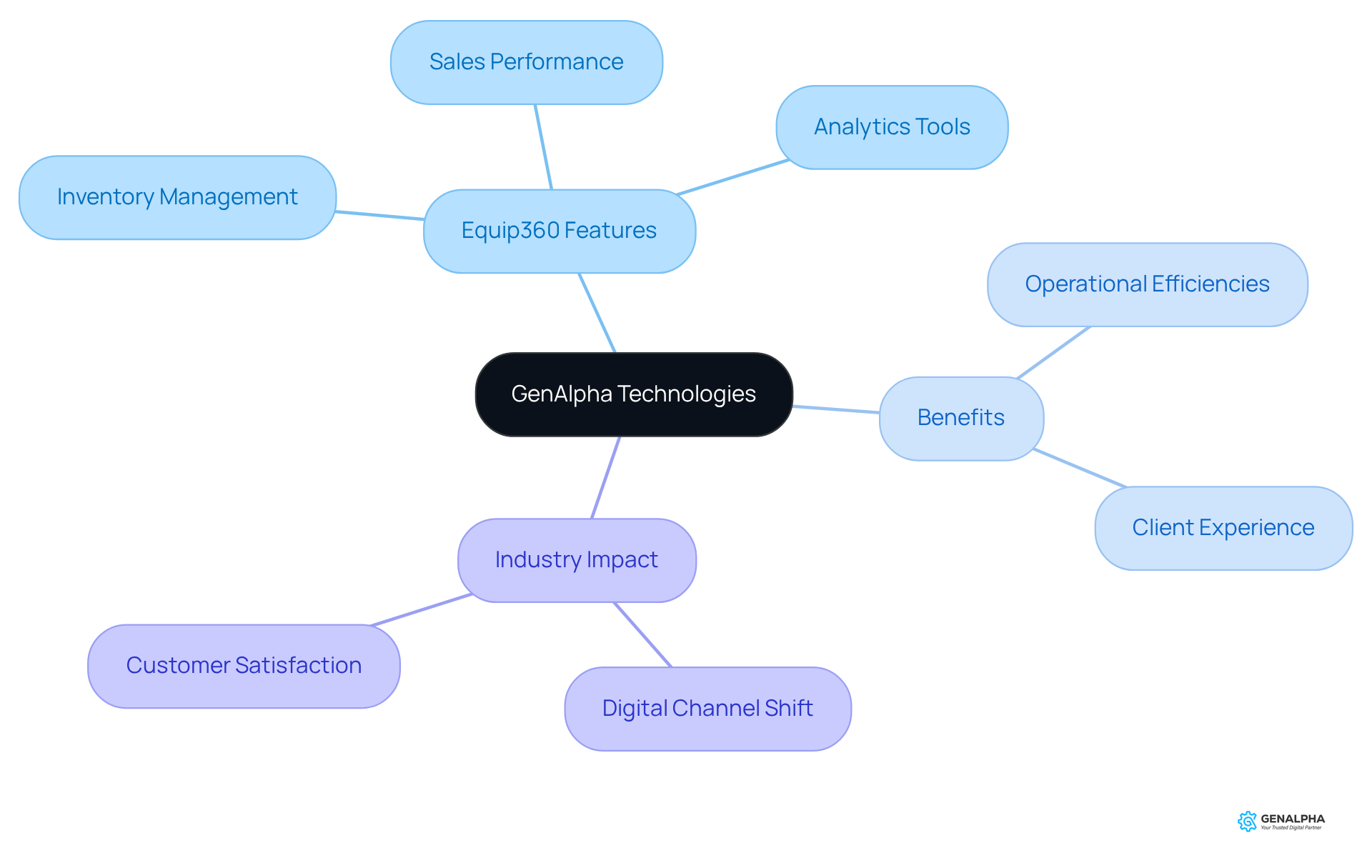
AI Integration: Enhancing Efficiency and Decision-Making in B2B Software
Artificial Intelligence (AI) is quickly becoming a key player in software B2B, and it’s making a real difference in how producers operate. Imagine automating those tedious routine tasks and using predictive analytics to make quick, data-driven decisions. Sounds great, right? For example, AI systems can dive into customer behavior patterns, helping producers fine-tune their offerings and boost customer satisfaction.
As more organizations jump on the AI bandwagon through software B2B, they’re likely to see some impressive gains in operational efficiency. Did you know that 62% of companies report an increase in revenue tied to strategic responses year after year? That’s significant! Leading organizations are six times more likely to have fully deployed AI agents across their revenue functions, providing them a competitive edge in the software B2B landscape of a fast-changing marketplace.
Looking ahead to 2025, we can expect AI to really shake up decision-making processes. Producers will be able to respond to market demands more efficiently, paving the way for ongoing growth. As Blue Bowen, a senior market research analyst at G2, puts it, "AI is set to revolutionize sales, not by replacing people, but by acting as an invaluable teammate." So, how are you planning to ?
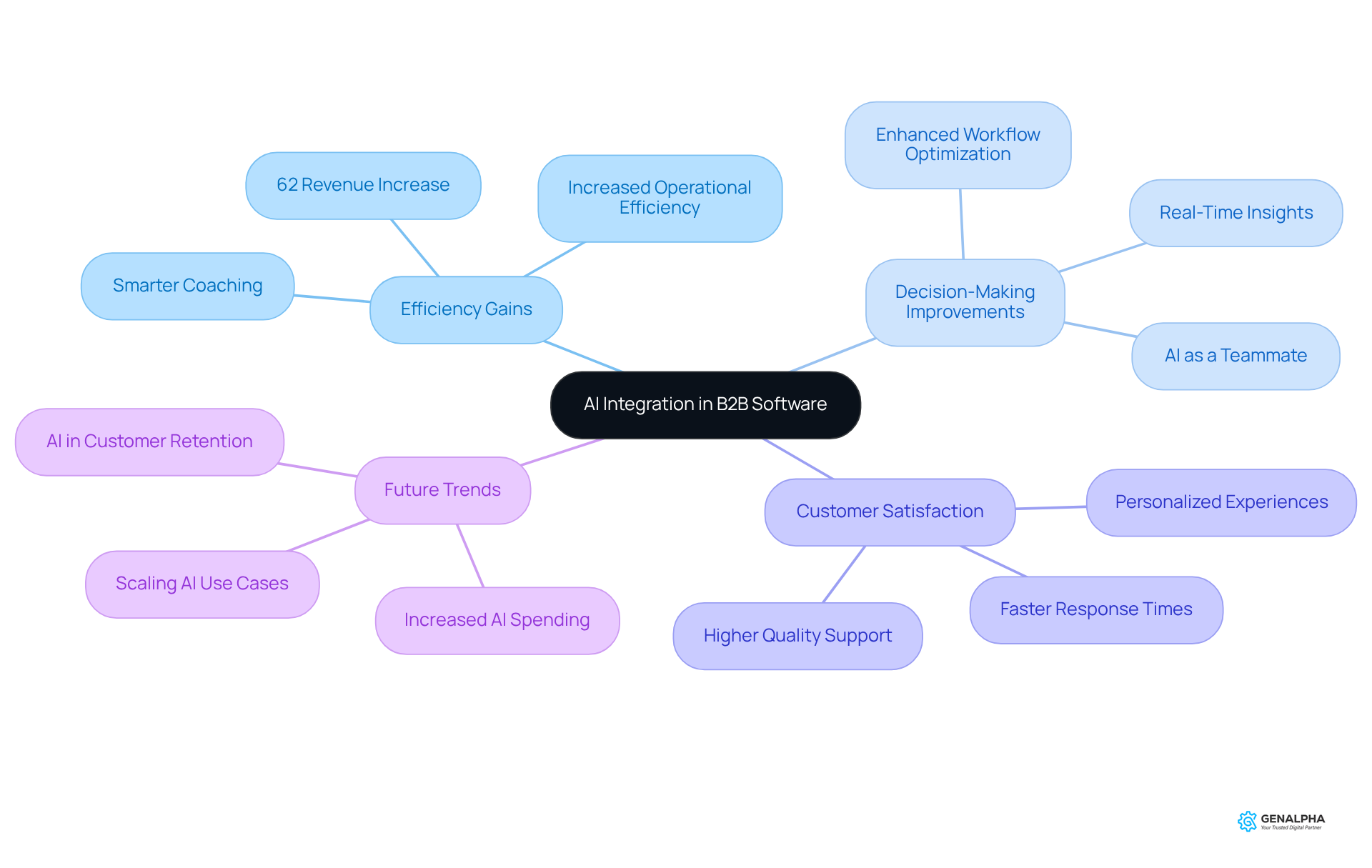
Cloud Solutions: Driving Flexibility and Scalability in B2B Operations
Have you noticed how cloud solutions are transforming software B2B operations? They offer an incredible level of flexibility and scalability. Imagine being able to adjust your IT resources on the fly to meet changing demands without breaking the bank. For example, producers can easily ramp up their cloud infrastructure during busy seasons to keep pace with increased production or sales. This kind of adaptability not only boosts but also empowers companies to innovate and respond to market shifts more effectively, helping them stay competitive in a fast-paced world.
Studies show that businesses leveraging AI-enabled cloud services could see a whopping 30% increase in operational efficiency by 2025 (Gartner). Isn’t that impressive? Plus, the global market for managed cloud services is expected to hit $64 billion by 2027, highlighting how crucial cloud technology is becoming in the manufacturing sector.
But as we embrace cloud adoption, it’s essential for manufacturers to stay vigilant about rising cybersecurity concerns. After all, safeguarding operations is key to long-term success. So, how prepared are you to navigate this evolving landscape?
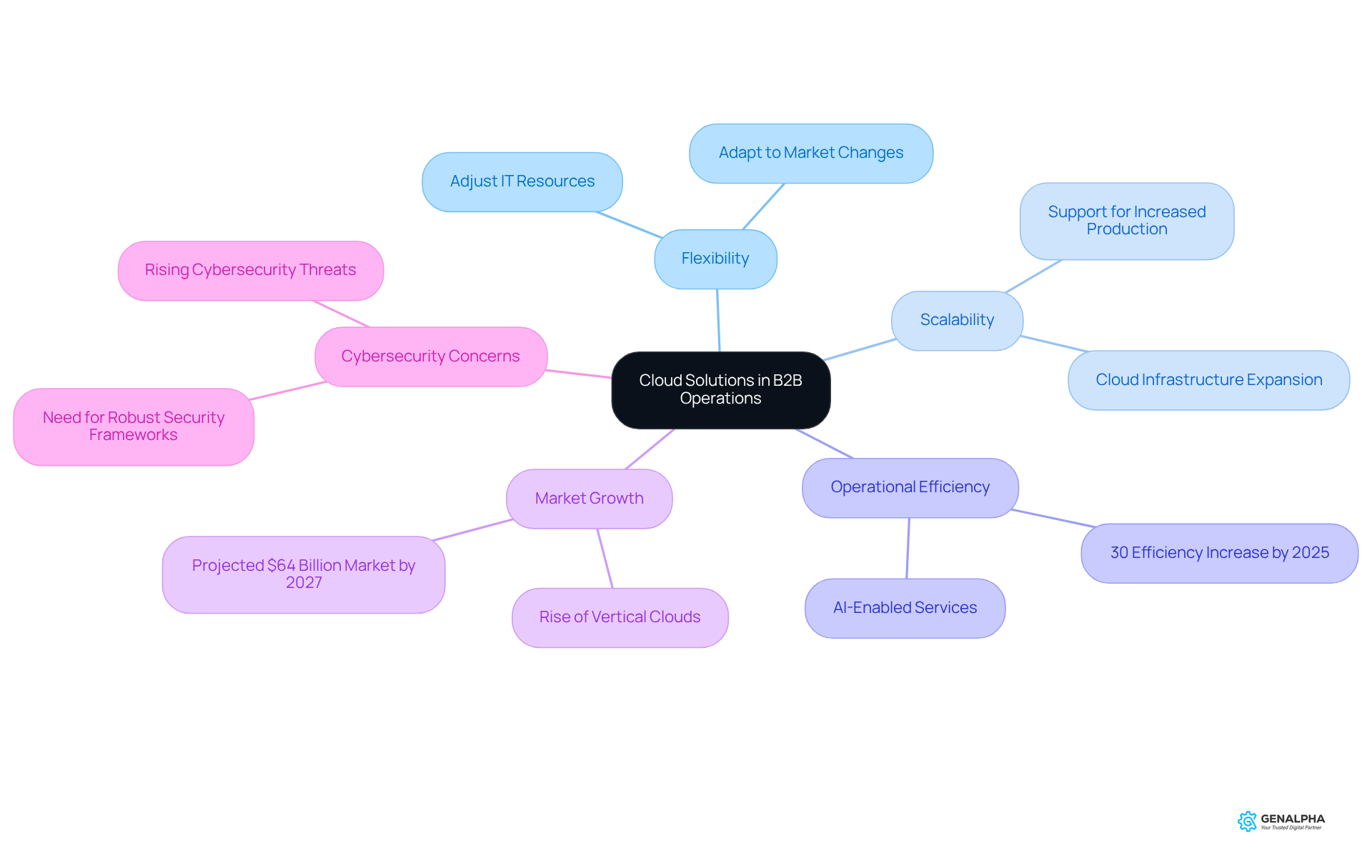
Customer Experience Optimization: Prioritizing User-Centric Software Design
In 2025, focusing on user-centered software design is crucial for boosting client experience in software B2B environments. Why? Because understanding user needs and preferences helps us create intuitive interfaces that make interactions seamless. For example, when we implement feedback loops and usability testing, we can pinpoint pain points in the purchasing process, allowing businesses to make informed adjustments. Companies that prioritize user experience often see significant boosts in client satisfaction, which fosters loyalty and drives sales growth. Did you know that personalized experiences can increase engagement by up to 80%? That’s a game changer for conversion rates (Tim Lindsay).
Moreover, businesses that emphasize user-focused design in form creation are likely to enjoy better profitability and client retention. As we adapt to these trends, focusing on clean, accessible design alongside streamlined shapes and responsive principles will not only enhance usability but also meet the rising expectations for software B2B to mirror the intuitive nature of consumer applications. Industry leaders like Salesforce, Atlassian, and Adobe are gaining a competitive edge by investing heavily in UX, underscoring the importance of these strategies in our ever-evolving landscape. So, how can your business start today?

Data Analytics: Leveraging Insights for Strategic Business Growth
Data analytics is super important for companies utilizing software B2B that are looking to tap into insights that fuel strategic growth. Have you ever thought about how [analyzing customer data](https://blog.genalpha.com/10-benefits-of-plm-product-lifecycle-management-for-manufacturers) can help businesses spot trends, understand preferences, and find areas for improvement? Predictive analytics really shines here, especially when it comes to forecasting demand. This allows producers to fine-tune their inventory levels and cut costs. For example, companies that have embraced predictive analytics often see significant drops in excess inventory, which in turn boosts their cash flow and operational efficiency.
Take 'GenAlpha Technologies' Equip360 platform as a prime example. It shows how predictive analytics can seamlessly fit into inventory management solutions, helping producers streamline their operations. Plus, these data-driven insights don’t just stop at inventory; they also shape marketing strategies. This means companies can reach out to the right audience with that resonate.
As more organizations hop on the data analytics train, they’re not just enhancing their decision-making processes—they're also paving the way for sustainable growth and carving out a competitive edge in the market. Looking ahead to 2025, it’s projected that 89% of top companies in the software B2B sector will be investing in AI to boost revenue growth. This makes leveraging customer insights through predictive analytics absolutely vital for producers who want to thrive in a rapidly changing landscape.
So, how can manufacturers effectively implement predictive analytics? It all starts with auditing existing data and pinpointing the key metrics that really impact inventory management. What steps will you take to get started?

Automation: Streamlining Processes for Enhanced Productivity
Have you noticed how automation is shaking things up in software B2B operations? It's all about making processes smoother and boosting productivity. Imagine automating those repetitive tasks like order processing, invoicing, and inventory management. This not only cuts down on errors but also frees up precious time. For example, think about how automated workflows can help orders get processed quickly and accurately—talk about happy clients!
But there’s more to it. Automation allows your team to focus on the bigger picture, like strategic planning and building customer relationships. This shift not only in software B2B but also enhances overall efficiency. So, why not embrace automation and see how it can transform your operations? Let’s dive into this exciting journey together!

Cybersecurity: Safeguarding B2B Transactions in a Digital World
In today's digital world, cybersecurity is essential for protecting transactions in software B2B. As manufacturers increasingly rely on online platforms for sales and communication, the threat of cyberattacks looms larger than ever. Think about it: a strong cybersecurity strategy isn't just a safety net; it's a must-have for any organization. Key practices like data encryption, multi-factor authentication, and regular security audits are crucial for safeguarding sensitive information and keeping client trust intact.
Did you know that by 2025, cyber incidents are expected to top the list of business risks? The cost of a data breach is on the rise too. Companies that embrace robust cybersecurity practices often see fewer data breaches, which is vital because such breaches can seriously damage brand reputation and client loyalty. By putting cybersecurity first, manufacturers can boost their operational resilience, enhance customer satisfaction, and secure their place in a competitive market.
Successful cybersecurity frameworks, including the adoption of the 'Zero Trust' model and the implementation of software B2B cyber audits, demonstrate that taking proactive steps not only protects assets but also builds stronger business relationships. Clients want to know their data is safe, and with the right measures in place, you can give them that assurance.
As we look ahead to 2025, the stakes are higher than ever. Manufacturers need to adapt to the ever-changing threat landscape to ensure sustainable growth and success in the software B2B industry. So, what steps are you taking to prioritize cybersecurity in your organization?
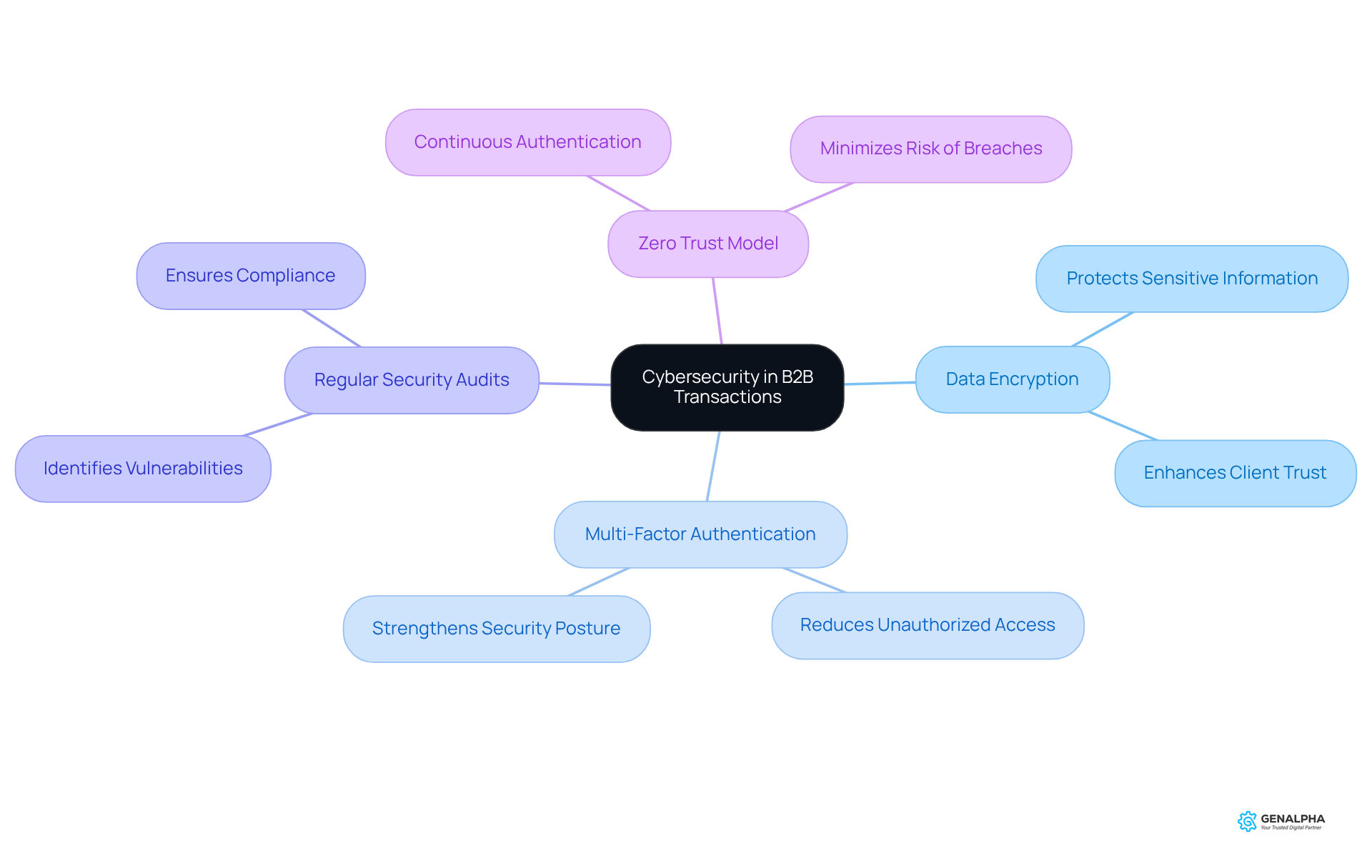
Subscription Models: Transforming Revenue Generation in B2B Software
Subscription models are shaking up how revenue is generated in the software B2B industry. They’re not just about making money; they create reliable income streams and build long-lasting relationships with clients. Did you know that the global subscription market is expected to hit a whopping $1.5 trillion by 2025? That really shows how important these models are becoming!
One effective way to tap into this trend is by implementing tiered subscription plans. This approach allows businesses to meet the diverse needs of their clients while ensuring a . Not only does this strategy boost client retention, but it also gives companies the chance to invest in continuous product improvements and robust client support.
As more organizations in the software B2B sector embrace subscription-based pricing, they’re likely to see a surge in client loyalty and sustainable growth. For instance, businesses that offer tiered plans can attract a broader audience by catering to different budgets and preferences. This ultimately enhances client engagement and loyalty.
Moreover, the pricing structure of subscription models is crucial for keeping clients on board. Competitive and transparent pricing can dramatically lower churn rates, which helps in building a loyal clientele. As Lincoln points out, maintaining client satisfaction is key to success in subscription models.
By harnessing tools like Darwin CX for managing subscription lifecycles, organizations can boost customer engagement and retention. Looking ahead to 2025, companies in the software B2B sector that effectively leverage subscription pricing strategies will be in a prime position to generate significant revenue and nurture strong client relationships.
And let’s not forget about inspiration from companies like Peloton! Their gamified experiences show how engagement strategies can really enhance retention and loyalty. So, what steps can you take today to embrace this subscription model trend and elevate your business?

Sustainability: Integrating Eco-Friendly Practices in B2B Software Solutions
Sustainability is becoming a big deal in software B2B solutions, right? More and more producers are realizing how important it is to adopt eco-friendly practices. By weaving sustainability into their operations, businesses can not only shrink their environmental footprint but also attract a growing number of socially conscious consumers.
For example, think about software solutions designed to optimize resource use and minimize waste. These tools help producers hit their sustainability targets while also boosting operational efficiency. As awareness of environmental issues grows, companies that prioritize sustainable practices are likely to enhance their brand reputation and build a loyal customer base.
Did you know that 63% of employees are worried about how automation and globalization might affect their futures? This shows a strong desire for companies to embrace responsible practices. Plus, the clothing industry alone could rake in an extra $500 billion through recycling initiatives, highlighting the financial perks of going green.
By leveraging innovative software B2B solutions, producers can establish themselves as leaders in sustainability. This not only fosters growth but also . So, why not take that step towards a greener future together?
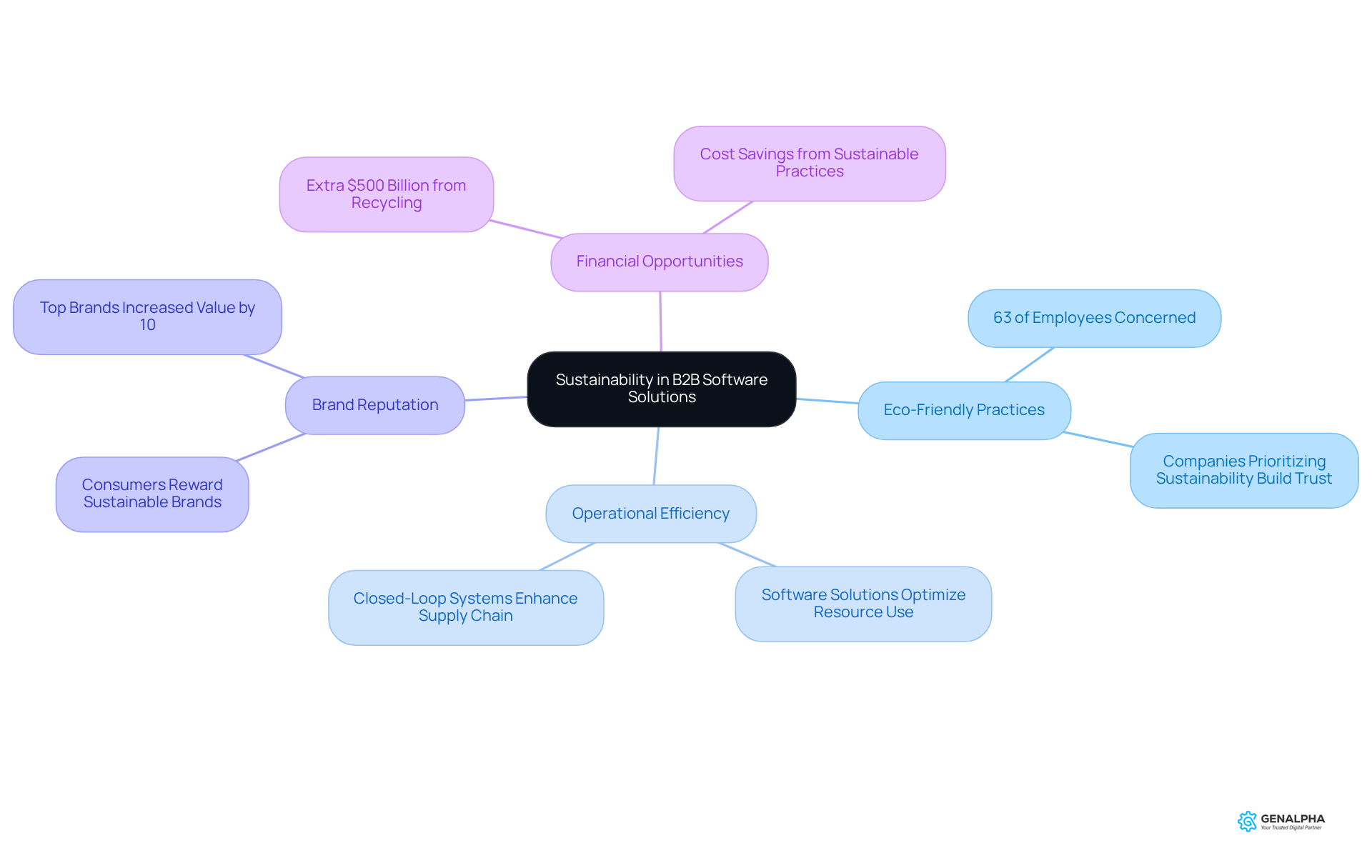
Integration Capabilities: Ensuring Cohesion Across B2B Software Systems
Have you ever thought about how crucial integration capabilities are for bringing together software B2B systems? As manufacturers dive into a variety of software B2B solutions to handle different parts of their operations, the need to connect these systems really stands out. When we talk about , we’re looking at a way to ensure that data flows smoothly, which can cut down on errors and improve decision-making.
For example, think about how integrating CRM systems with inventory management software can provide real-time insights into stock levels and customer orders. This means businesses can quickly adjust to what the market demands. Prioritizing integration in software B2B doesn’t just make operations run more efficiently; it also fuels sustainable growth, setting companies up for success in the competitive landscape of 2025.
So, how are you planning to leverage integration in your business strategy?
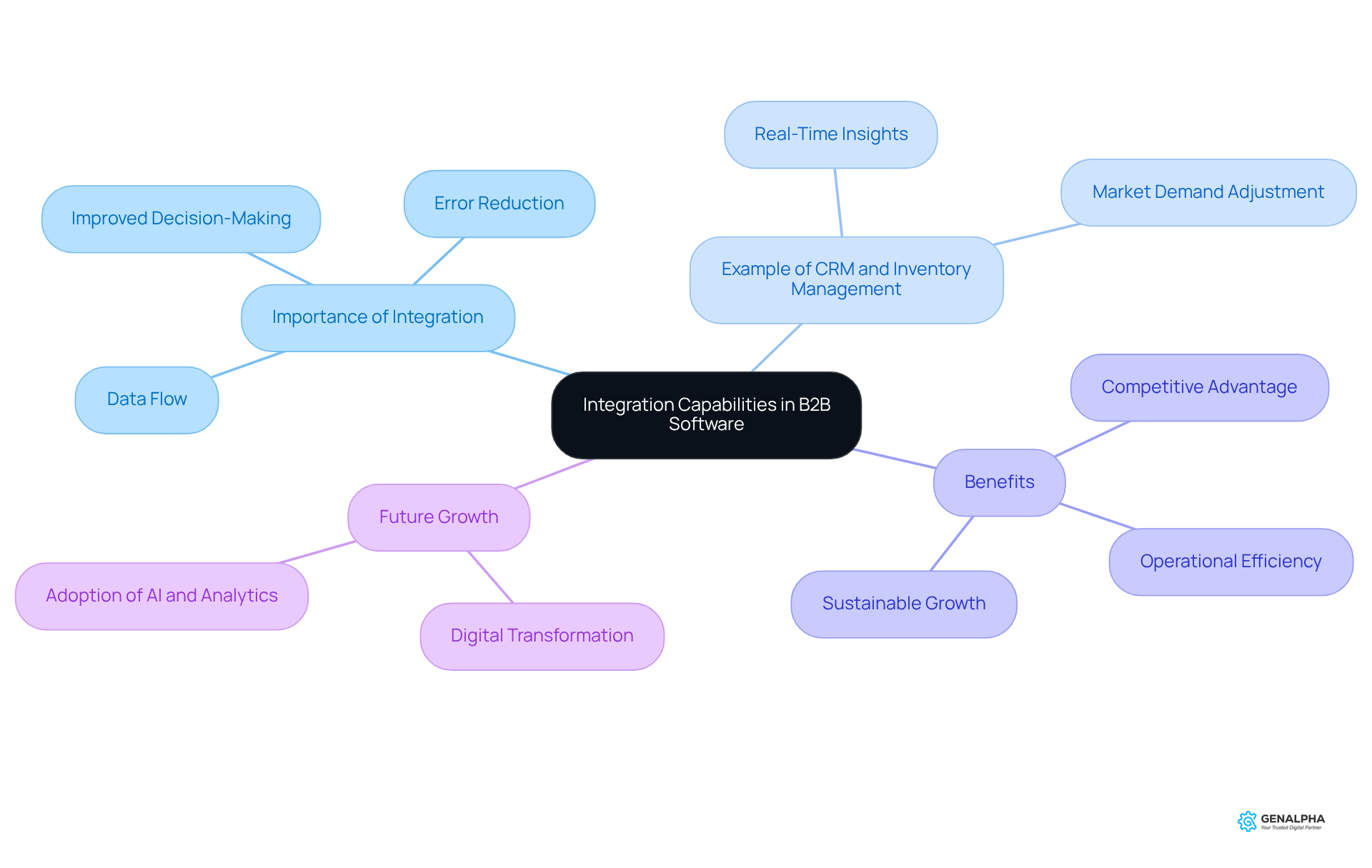
Conclusion
As the world of software B2B for manufacturers continues to change, embracing innovative technologies and strategies is more important than ever. Think about it: trends like AI integration, cloud solutions, and user-centric design aren’t just nice-to-haves; they’re essential for manufacturers who want to thrive in the competitive landscape of 2025. By recognizing and adapting to these shifts, businesses can boost operational efficiencies, enhance customer experiences, and ultimately drive sustainable growth.
Throughout this article, we've explored various trends, including:
- How GenAlpha Technologies are transforming eCommerce
- The role of data analytics in strategic decision-making
- The critical need for robust cybersecurity measures
Each of these elements is vital in shaping a resilient and forward-thinking manufacturing sector. Plus, the rise of subscription models and the focus on sustainability underscore the importance of adaptability in revenue generation and corporate responsibility.
Looking ahead, manufacturers need to take proactive steps to weave these trends into their business strategies. By investing in technology and prioritizing customer-centric approaches, companies can not only protect their operations but also position themselves as leaders in their industries. The message is clear: let’s embrace these innovations now—not just to survive but to truly thrive in the fast-evolving world of B2B software. What steps will you take today to stay ahead of the curve?
Frequently Asked Questions
What is GenAlpha Technologies known for in the B2B eCommerce space?
GenAlpha Technologies is recognized for revolutionizing B2B eCommerce, particularly for manufacturers and distributors, with their product Equip360, which optimizes inventory management and enhances digital sales performance.
How does Equip360 benefit businesses?
Equip360 improves operational efficiencies and provides analytics tools that unlock data-driven insights, helping businesses streamline operations and enhance client experiences.
What significant trend is occurring in the parts ordering process due to eCommerce solutions?
Within just a year of implementing eCommerce solutions, 80% of parts orders shift to digital channels, indicating a major trend towards online transactions.
What impact does GenAlpha's technology have on client relationships?
The advancements from GenAlpha not only boost sales efficiency but also strengthen client relationships, making them a key player in the digital transformation of the manufacturing industry.
How is AI transforming B2B software operations?
AI is automating routine tasks and utilizing predictive analytics for quick, data-driven decisions, helping producers optimize their offerings and enhance customer satisfaction.
What are the reported benefits of companies adopting AI in their operations?
62% of companies report an increase in revenue linked to strategic AI responses, and leading organizations are six times more likely to have fully deployed AI agents across their revenue functions.
How are cloud solutions impacting B2B operations?
Cloud solutions provide flexibility and scalability, allowing businesses to adjust IT resources according to demand, which boosts operational efficiency and enables innovation.
What potential increase in operational efficiency is projected for businesses using AI-enabled cloud services by 2025?
Businesses leveraging AI-enabled cloud services could see a 30% increase in operational efficiency by 2025.
What is the expected market growth for managed cloud services by 2027?
The global market for managed cloud services is expected to reach $64 billion by 2027, underscoring the importance of cloud technology in the manufacturing sector.
What should manufacturers be cautious about as they adopt cloud solutions?
Manufacturers need to be vigilant about rising cybersecurity concerns to safeguard their operations and ensure long-term success.




